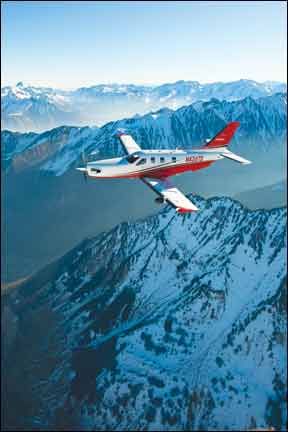When you put a sharp pencil to it, a 20-knot speed advantage for one airplane over another really isn’t squat. It amounts to 12 minutes on a 500-mile trip. But how about 50 knots or even 100? On a 1000-mile trip, that’s the difference between landing just in time for dinner or arriving early enough for a round of golf and cocktails. Above 300-knots cruise speed, the space-time scale shifts and that’s where the Daher-SOCATA TBM850 lives.
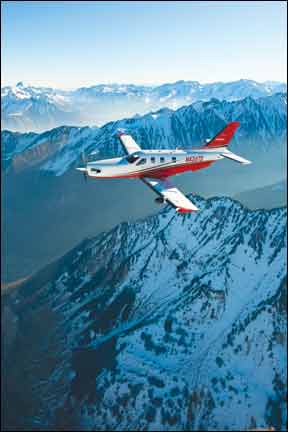
The airplane is a no-apologies, uncompromised high-altitude personal transportation aircraft that enjoys, if not high-volume sales, a loyal following and an improved market thanks to the lukewarm blooming of the very light jet market. Daher-SOCATA is positioned to sell about 30 to 50 TBM850s a year and although the company sees an international market for the airplane, most of its sales are in the U.S. where there’s enough wealth to support the $3.4 million sales price. What do you get for that? An honest, 300-knot airplane with sophisticated automation, a comfortable 1200-mile range and a cabin that seats four with flexible loading options that make it practical to carry large and heavy cargo, in addition to a couple of passengers. A recent additional pot sweetener is free maintenance on everything but consumables for a period of five years. If it sounds like Daher-SOCATA is confident in the reliability of the TBM850, they seem to be just that.
Model History
The 850 traces its roots to the early 1980s, when a group of French investors bought Mooney just as the company was developing a big cabin-class piston single to compete with the Cessna 210 and, eventually, the Malibu. That Roy LoPresti-developed airplane, the 301, flew in 1983, but it never reached production because the investors thought it would be too slow at 260 knots. (That is, by the way, about the cruise speed of two of the TBM850’s competitors.)
Since Mooney didn’t have the resources to redevelop the airplane as a turbine, the investors set up a joint venture with SOCATA. What followed was development by SOCATA that eventually yielded the TBM700, which appeared in late 1990 at a price of about $1.3 million. Although Mooney and SOCATA parted ways, the “M” in TBM derives from the Mooney connection, with the TB meaning Tarbes-built, where the airplanes are still manufactured. Originally, Mooney’s Kerrville plant was supposed to run a second line for the TBM700, but it never happened. The TBM700 proved a good seller, albeit in that small volume niche of the expensive, owner-flown turbine market. Even against newer designs such as the Pilatus PC-12 and the Piper Meridian, the TBM700 was fast, touching 300 knots, although real-world cruise speeds were less.
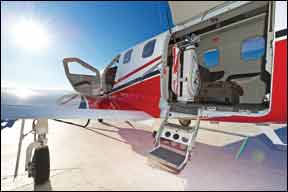
With the success of the TBM700—some 324 were sold—SOCATA saw room for a faster variant that could climb and cruise quicker, but carry about the same load, if not a little more. Thus was hatched the TBM850, with a more powerful PT6A-66D engine and, since 2008, glass cockpits and digital autopilots.
Flexible Cabin
The airplane itself is not huge; think of it as a cross between a King Air and a Malibu. Wingspan is 41.6 feet with a fuselage length of 35.9 feet. That might fit in the largest T-hanger, but at 14.3 feet, the tail might not clear the door. Large box or group hangars are the more likely choices. The cabin is about 4 feet wide and tall, not quite tall enough for standing up.
Unusual for pressurized airplanes, the TBM850 has a large, top-hinged main cabin door reminiscent of an airplane intended for cargo. The version we flew had four cabin seats in club arrangement, but all 850s for 2012 have the option of re-configuring for two cabin seats, opening an enormous rear area for cargo or luggage.
With full fuel, the TBM850 has payload of between 830 and 900 pounds. So with four people aboard, you could stuff another 150 to 300 pounds into the airplane. Fueled for 900 miles (200 gallons), you can fill the seats and still have more than 400 pounds of additional payload.
In the real world, says SOCATA’s CEO, Nicolas Chabbert, owners tend to fly with two or three aboard and full tanks. Even if they don’t stretch the airplane’s range, the additional fuel offers alternate options in poor weather, which this class of airplane is likely to tackle. (It’s fully de-iced with bleed-air inflated pneumatic boots.)
Because the cabin is not quite as wide as larger turboprop twins, getting into the cockpit through the seat aisle from the rear is a squeeze. SOCATA’s solution to this is a crew door for the pilot, with a small folding step. You can thus load the passengers and secure the main door, then man up the front.
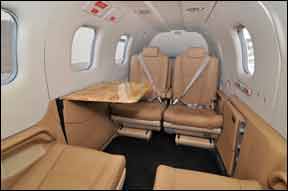
The TBM850 appeared in 2006 as the TBM700 follow-on. The early airplanes had steam gauges but as of 2008, all are Garmin G1000 equipped, with two EFIS displays and a 15-inch center MFD. Current models have Garmin’s GFC700 autopilot and most are shipped with a wing-mounted pod for ship’s radar. The G1000 airplanes are lighter enough to have picked up 20 additional pounds of payload.
Airplanes in this class are typically shipped with all the options, but the TBM850 has so many standard features that the list isn’t very long. The cabin can include a chemical toilet and cabinets, and buyers can spec customized paint and interior wood trim, among the add-ons. Before 2010, a five-year maintenance plan was an option, but now it’s standard. That includes five annuals and all repairs involving non-consumables, a deal that strikes us as a strong sales point.
“More and more, people don’t want to deal with it. They want us to do all the maintenance,” Chabbert says. This can be done at any of SOCATA’s 14 U.S. service centers, one of which is at North Perry Airport in Florida.
Typical invoices, says Chabbert, are in the $3.4 million range, a price point a bit above the Cessna Mustang and we’ll above the Piper Meridian at about $2.1 million. Although not a direct competitor, the other big turboprop in this space, the Pilatus PC-12, sells for about $4.3 million. As Chabbert explains on page 13, SOCATA sees definite daylight between the appeal and cost of operation of its large single-engine turboprop and an entry-level jet such as the Cessna Mustang or the revitalized Eclipse.
“We are more head to head with the VLJs, which probably has to do with price. We used to have competition with the [Embraer] Phenom, but not so much anymore,” Chabbert says.
Big Engine
To make an airplane climb and cruise faster, the simple solution is more horsepower and that’s what SOCATA did with the TMB850. The previous model had a Pratt & Whitney PT6A-64, with 700 HP while the 850 has a PTA-66D, with 850 shaft horsepower. These are essentially the same engine, but the 66D has improved metallurgy in its compressor section that allows higher operating limits and thus more power. The -64 was limited to 800 degrees ITT while the -66 allows 850 degrees, which, in operation, the airplane doesn’t seem to approach.
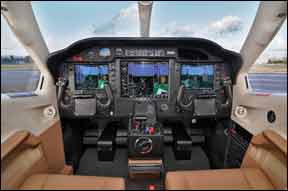
Adding another 150 HP—21 percent—posed some certification and engineering challenges related to handling all that torque, especially on takeoff. SOCATA addressed this simply and directly by designing the TBM850 to operate in two engine modes, 700 HP and 850 HP. The higher value is locked out by a switch on the flap control. After takeoff, with the flaps retracted from the takeoff position, you can slide the selector to 850 mode and enjoy the marvel of 2000 FPM climbs. The -66D can best be described as a semi-FADEC engine. With 700-HP mode engaged, it’s automatically torque limited. But in either mode, there are no automatic temperature protections, so the pilot is on his own to guard the fuel if a hot start or other over-temp event occurs.
“Most hot starts are because of a weak battery,” SOCATA’s demo pilot, Wayman Luy, told us. Training for the TBM850 also encourages pilots to have the airplane towed into the wind before start. “Downwind starts are a real no-no,” Luy adds.
Managing these temperatures isn’t particularly difficult, once you know where to look for the gauge—a virtual analog represented on both the PFD and MFD. Other than adding fuel at 13 percent Ng, startup is mostly automatic. Given the 850’s extensive automation, we wondered if it will ever get a full FADEC-protected engine.
“We have asked this of Pratt & Whitney,” Chabbert says. “The economics just aren’t right. The costs would go through the roof for this engine.” While we’re on costs, Michel De Villiers, SOCATA’s VP of sales, quotes a flat $100 an hour for maintenance and reserve costs on the engine, plus fuel. Block-to-block fuel consumption is in the 60 GPH range, depending on altitude and power setting.
Flying It
As with every other modern airplane we’ve flown, the G1000 stands between the pilot and simplified operation. If you’re current and comfortable on the system, the airplane kind of tags along with your operation of the avionics. And this is very much an autopilot airplane, from initial climb to pre-landing. SOCATA has a six-day initial program at Simcom and insurers generally require once-a-year recurrency. If you came in knowing the G1000 cold, this is a generous amount of time, for it’s a remarkably simple airplane to fly and hard to get into trouble in, even for the ham handed.
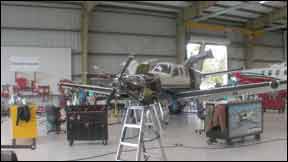
Perhaps the biggest challenge is just staying with or a little ahead of its raw speed. At 2000 FPM per minute, you can blow through a low-altitude IFR restriction in a heartbeat, thus knowing how to arm the autopilot for altitude capture is critical if you lack anticipatory position awareness. On descent, this will be magnified, because it’s hardly unusual to see 350 or 400 knots groundspeed with a good push. Fortunately, the GFC700 can easily handle things like programmed descents and crossing restrictions, if you know how to tickle the right keys.
If anything surprised us, it’s how we’ll this airplane handles on the ground. Wayman Luy had us try some 360-degree turns to the right and left in a taxiway hammerhead that appeared to lack anything like the space to do it. If the airplane doesn’t turn in its own length, it certainly feels like it. During taxi, speed is controlled with short squirts of Beta, to offset the fact that those two exhaust stacks are churning out quite a bit of thrust, even at idle.
The airplane has a little forward thrust just off the idle stop in Beta. Retracting the throttle commands more reverse. The 850 has both aileron and rudder trim and the latter is necessary to keep rudder pressure manageable during the takeoff roll. This isn’t exactly a P-51, but it’ll push you back into the seat and head for the left-side ditch if you’re snoozing.
Luy had us line up on the centerline with brakes locked. Advancing the torque to 50 percent and releasing the brakes gets the airplane rolling, which it does as if on rails. The G1000 presents a small white power-set caret—a little over 100 percent torque—and once you’re there, wait for 65 knots and tug the pitch up to 7 degrees. The TBM seems to show its Mooney origins in that it doesn’t bolt to triple digits but kind of collect itself up, accelerates and settles into a robust climb between 130 and 140 knots. Moving the flap switch to 850-mode will push the climb rate to 2000 FPM. This sounds like a surfeit of performance but it will, in fact, turn you into a beggar because what the TBM850 craves more than anything else is unrestricted climbs. This allows it to reach its top cruising speeds in the 20s and low 30s and that will substantially reduce fuel flow. On the ground, the engine is burning 33 GPH at idle and that doubles in low-altitude climb. In the high 20s on a standard day, fuel flow is more like 55 to 60 GPH and to wring maximum range out of the airplane, you need to get high as quickly as possible and stay up there as long as possible. At 10,000 feet, fuel would be disappearing at 75 GPH.
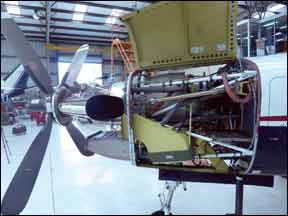
On a previous flight with Nicolas Chabbert, level at FL280, we were motoring along at 308 knots true, right on the book speed, and called up the Garmin’s range map, which showed we could make it to Boston, with reserves, from south Florida. But, Chabbert pointed out, ATC often doesn’t play.
“When you get to New York, you will be pushed down and the fuel flow goes up,” he says. Depending on the wind, this can make reaching the flight-planned destination iffy, an illustration of the most critical skill new turbine pilots have to learn: dynamic fuel planning on max range flights.
SOCATA also encourages pilots to take advantage of one of the TBM850’s other tricks: It will descend like a box of hammers if the power is pulled to flight idle and the nose is pushed over to VMO, which is 266 knots indicated. On our flight with Luy, we saw 9500 FPM in descent. It’s practical to remain in the flight levels until within 25 miles of the airport, idle the power, dump the nose and slow to enter the pattern five miles out.
Once in the pattern, the 850 fits into the flow without much fuss. For our first landing, we flew a turbine-style pattern at 1500 feet AGL and outside the rest of the traffic. But the airplane is perfectly civil at 90 knots in the downwind and 85 knots on final—basically Cirrus speeds.
Luy suggesting running the pitch trim to the uptrim stop and just let the airplane fly itself on, which it does, requiring only a mild tug and light control pressure to coax it into the flare. If you want to stop right now, yank the Beta to the rear stop and push the nose down and get on the brakes. The POH says this thing will get in under 2000 feet with maximum braking but no reverse. We didn’t try it, but our turnoff occurred at about 2200 feet, without trying very hard.
Our estimation of the TBM850 is that it’s exactly what Daher-SOCATA says it is. Blisteringly fast personal transportation that’s comfortable without excess gilding and easily and safely flyable by a guy not named Steve Canyon.

